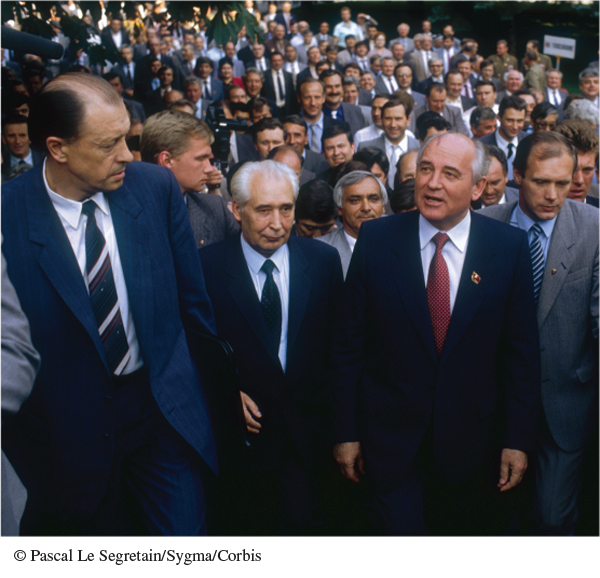Gorbachev’s Reforms in the Soviet Union
Cold War tensions aside, the Soviet Union’s Communist elite seemed safe from any challenge from below in the early 1980s. A well-established system of administrative controls stretched downward from the central ministries and state committees to provincial cities and from there to factories, neighborhoods, and villages. At each level of this massive state bureaucracy, the overlapping hierarchy of the 17.5-million-member Communist Party maintained tight state control. Organized opposition was impossible, and average people left politics to the bosses.
Although the massive state and party bureaucracy safeguarded the elite, it promoted widespread apathy and stagnation. When the ailing Brezhnev finally died in 1982, his successor, the long-time chief of the secret police, Yuri Andropov (1914–1984), tried to invigorate the system. Relatively little came of his efforts, but they combined with a sharply worsening economic situation to set the stage for the emergence in 1985 of Mikhail Gorbachev (b. 1931), the most vigorous Soviet leader in a generation.
A lawyer and experienced Communist Party official, Gorbachev was smart, charming, and tough. He believed in communism, but realized that the Soviet Union was failing to keep up with the West and was losing its superpower status. Thus Gorbachev tried to revitalize the Soviet system with fundamental reforms. An idealist who wanted to improve conditions for ordinary citizens, Gorbachev understood that the enormous expense of the Cold War arms race had had a disastrous impact on living conditions in the Soviet Union; improvement at home, he realized, required better relations with the West.
In his first year in office, Gorbachev attacked corruption and incompetence in the bureaucracy and consolidated his power. He condemned alcoholism and drunkenness, which were deadly scourges of Soviet society, and worked out an ambitious reform program designed to transform and restructure the economy in order to provide for the real needs of the Soviet population. To accomplish this economic restructuring, or perestroika (pehr-uh-STROY-kuh), Gorbachev and his supporters permitted an easing of government price controls on some goods, more independence for state enterprises, and the creation of profit-seeking private cooperatives to provide personal services. These timid reforms initially produced a few improvements, but shortages grew as the economy stalled at an intermediate point between central planning and free-market mechanisms. By late 1988 widespread consumer dissatisfaction posed a serious threat to Gorbachev’s leadership and the entire reform program.

Mikhail Gorbachev Soviet president Mikhail Gorbachev (center, with red tie) walks with a crowd of delegates to the twenty-eighth and last congress of the Soviet Communist Party in July 1990. Gorbachev took office in 1985 with the goal of reforming communism from within. His plans spiraled out of control. By 1991 the Soviet Union and the East Bloc had disintegrated into independent, noncommunist states.
(© Pascal Le Segretain/Sygma/Corbis)
Gorbachev’s bold and far-reaching campaign for greater freedom of expression was much more successful. Very popular in a country where censorship, dull uniformity, and outright lies had long characterized public discourse, the newfound openness, or glasnost (GLAZ-nohst), of the government and the media marked an astonishing break with the past. Long-banned émigré writers sold millions of copies of their works in new editions, while denunciations of Stalin and his terror became standard fare in plays and movies. In another example of glasnost in action, after several days of hesitation the usually secretive Soviet government issued daily reports on the 1986 nuclear plant accident at Chernobyl, one of the worst environmental disasters in history. Indeed the initial openness in government pronouncements quickly went much further than Gorbachev intended and led to something approaching free speech, a veritable cultural revolution.
Democratization was another element of reform. Beginning as an attack on corruption in the Communist Party, it led to the first free elections in the Soviet Union since 1917. Gorbachev and the party remained in control, but a minority of critical independents was elected in April 1989 to a revitalized Congress of People’s Deputies. Millions of Soviets then watched the new congress for hours on television as Gorbachev and his ministers saw their proposals debated and even rejected. Thus millions of Soviet citizens took practical lessons in open discussion, critical thinking, and representative government. An active civil society was emerging — a new political culture at odds with the Communist Party’s monopoly of power and control.
Democratization also ignited demands for greater political and cultural autonomy and even national independence among non-Russian minorities living in the fifteen Soviet republics. The Soviet population numbered about 145 million ethnic Russians and 140.6 million non-Russians, including 55 million Muslims in the Central Asian republics and over 44 million Ukrainians. Once Gorbachev opened the doors to greater public expression, tensions flared between central Soviet control and national separatist movements. Independence groups were particularly active in the Baltic Soviet socialist republics of Lithuania, Latvia, and Estonia; in western Ukraine; and in the Transcaucasian republics of Armenia, Azerbaijan, and Georgia.
Finally, Gorbachev brought reforms to the field of foreign affairs. He withdrew Soviet troops from Afghanistan in February 1989 and sought to reduce East-West tensions. Of enormous importance, the Soviet leader sought to halt the arms race with the United States and convinced President Reagan of his sincerity. In a Washington summit in December 1987, the two leaders agreed to eliminate all land-based intermediate-range missiles in Europe, setting the stage for more arms reductions. Gorbachev pledged to respect the political choices of the peoples of East Bloc countries, repudiating the Brezhnev Doctrine and giving encouragement to reform movements in Poland, Czechoslovakia, and Hungary. By early 1989 it seemed that if Gorbachev held to his word, the tragic Soviet occupation of eastern Europe might wither away, taking the long Cold War with it once and for all.
